If one of the United States is known for its reptiles, it has to be Florida. The varying ecosystems, the huge amounts of swamps, and the warm climate all allow reptiles to thrive. Like it or not, reptiles, especially snakes, are a part of a Floridian’s life. Finding a snake in your yard or while hiking can be a scary (or fun) event, depending on whether you like snakes in general. Obviously, the next step is to identify it! With so many black snakes in Florida, it can be quite a task. Thankfully, we compiled a list of all the most common black snakes in Florida to help you identify what species they are. Let’s get started.
Figuring out which snake you found
Identifying a snake is about getting all the information you can and putting it together to form a whole picture. We have a list of the 10 most common black snakes in Florida, along with some helpful information that can narrow things down. Our identification elements are as follows:
- Appearance
- Distribution within Florida
- Habitat
- Danger level
Each snake entry will include this information to aid you in identifying the black snake you stumbled across! Here are the 10 most likely options.
Eastern Indigo
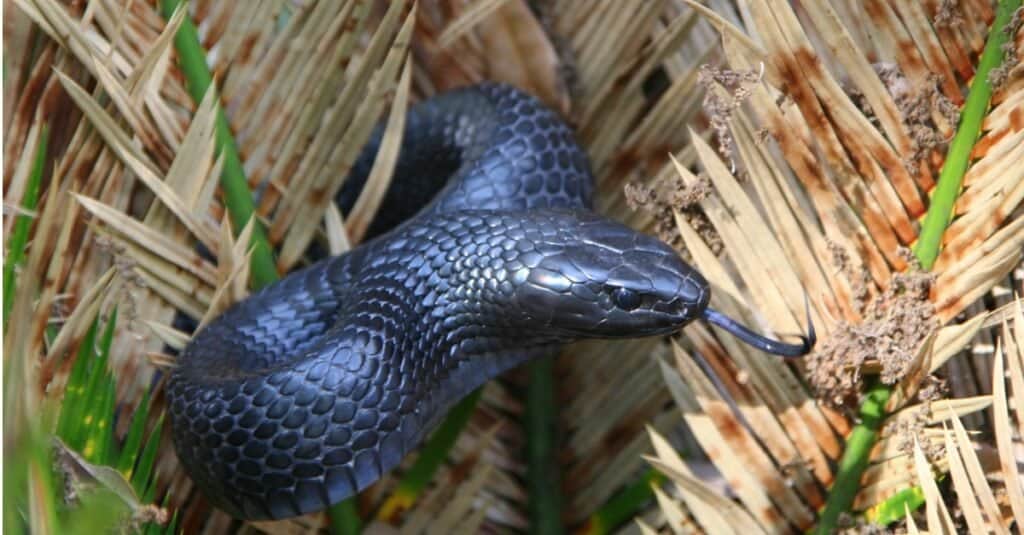
The eastern indigo snake is a large nonvenomous snake native to the Eastern United States. Its head and body are about the same size, and it doesn’t have much of a neck.
©iStock.com/sstaton
Eastern indigo snakes are some of the most beautiful snakes around. Jet black and sleek as can be, these snakes are known as the longest snake in North America. Seeing one of these is a treat.
Appearance: Glossy black. Sleek scales. Occasionally has a red marking on the chin. Can reach over 8 feet in length.
Distribution: Most of Florida and into Key Largo.
Habitat: Forests, pine stands, prairies, usually around water.
Danger level: Low. Nonvenemous and disinclined to bite humans, preferring to be left alone.
Eastern Hognose
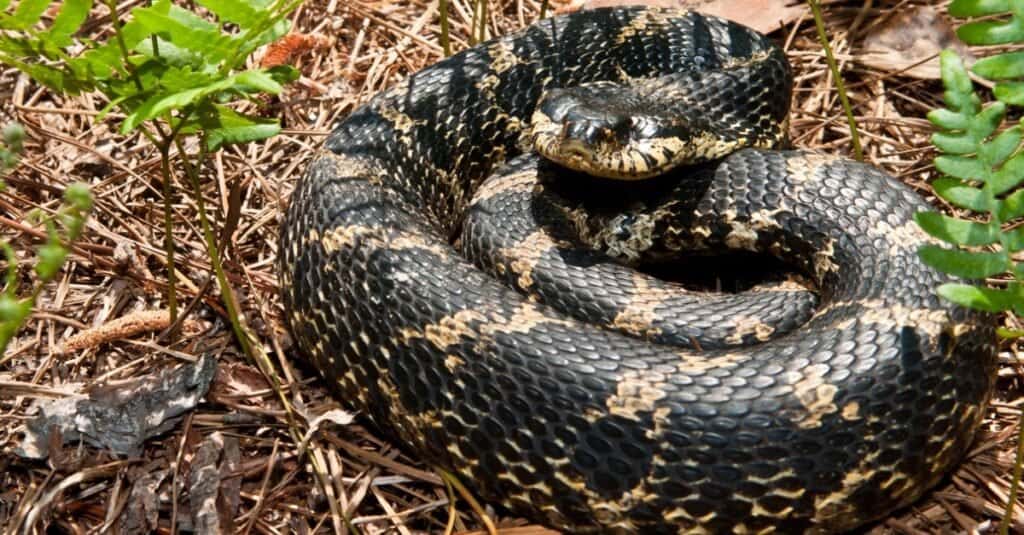
Eastern hognose snakes are famous for playing dead when threatened.
©iStock.com/JasonOndreicka
The eastern hognose is one of the most interesting-looking snakes around, as you may be able to tell from its name. They are usually dark grey to brown, but some snakes can be so dark as to appear black. Famous for “death-feigning” when threatened in the hopes of dissuading potential predators.
Appearance: Dark grey, brown, occasionally black. Identifiable through its long pointed snout that turns upward. Can grow up to 3 feet long.
Distribution: Almost all of Florida except the Keys.
Habitat: Scrubland, fields, agricultural regions, meadows, forests, and sandhills.
Danger level: Medium. Venom is only powerful enough to sedate a frog and would only cause irritation in a human. Reticent to bite.
Black Racer
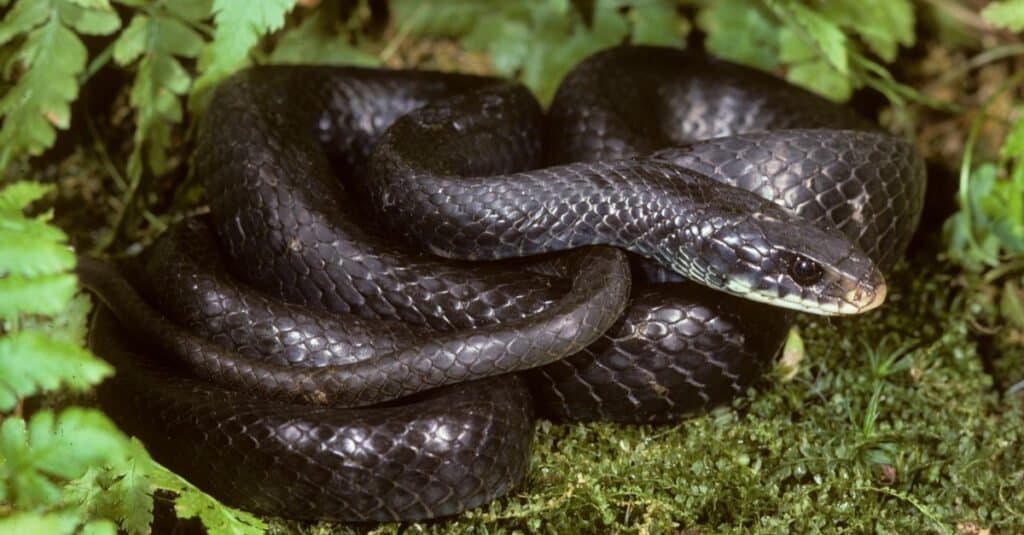
The black racer is an agile and very fast animal that can move at 4 miles per hour when it is threatened, hence the name “racer”.
©Breck P. Kent/Shutterstock.com
The black racer is one of the most common snakes in the US and one of the most common black snakes in Florida. They can be found all over, but most encounters with humans happen in suburban areas. They get the “racer” part of their name from their speed, and they are known to swim and climb trees to escape predators; a real triathlete!
Appearance: Dark grey to black. Long and thin with small, teardrop heads and large eyes.
Distribution: Most of Florida, including the Keys.
Habitat: Forests, pine stands, scrub, sandhills, and suburbs.
Danger level: Low. Nonvenomous, but will strike if threatened.
Eastern Kingsnake
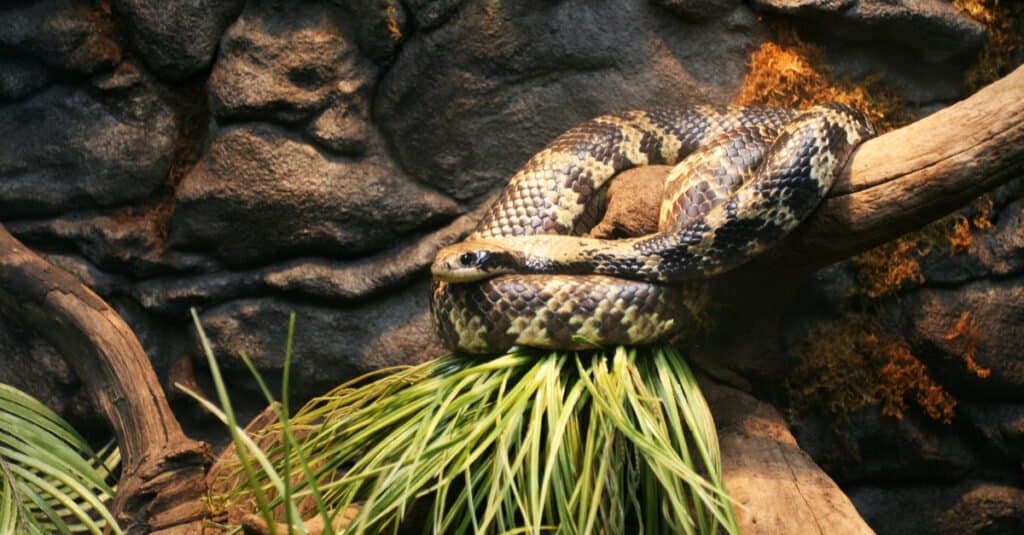
The Florida Kingsnake is immune to the
venom of other snakes
in its habitat, including rattlesnakes.
©David Huntley Creative/Shutterstock.com
The eastern kingsnake gets its name from its habit of eating other snakes, especially venomous ones. The kingsnake can come in many colors, but black with white stripes is most common. Kingsnakes have the strongest constriction relative to the size of any snake in the world.
Appearance: Usually black with white or yellow bands around the body, but coloration can vary drastically. Can grow up to 4 feet in length.
Distribution: Peninsular Florida and into the panhandle. Population declines through most of the state.
Habitat: Pine stands, marshes, and cypress stands. Usually found near water.
Danger level: Low. Kingsnakes are often kept as pets and are nonvenomous.
Southern Ringneck
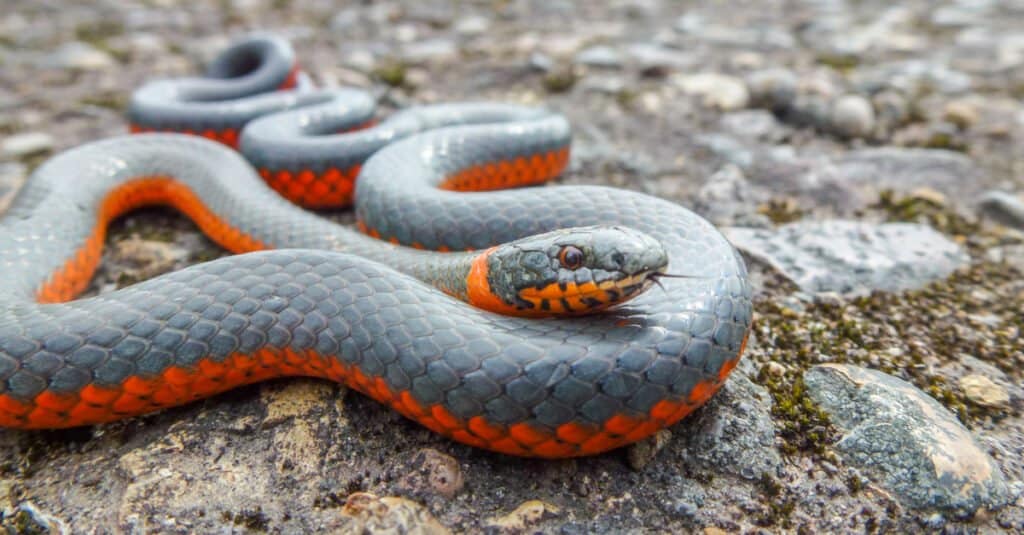
Ringneck snakes
are named after the collars of color around their necks.
©Tom Fenske/Shutterstock.com
The southern ringneck is one of the prettiest snakes in the US. These small snakes are characterized by a small ring around their neck, much like a collar. Their bellies are usually flashed as a warning to predators and come in bright shades of red, yellow, and orange.
Appearance: Usually black or grey with a colorful ring around the neck. Bright and vibrant belly that is flashed as a defense mechanism. Can grow to 10 inches in length.
Distribution: All of Florida, including the Keys.
Habitat: Meadows, pine forests, prairies, and fields.
Danger level: Low. Mildly venomous, but it’s not dangerous to people.
Brahminy Blind Snake
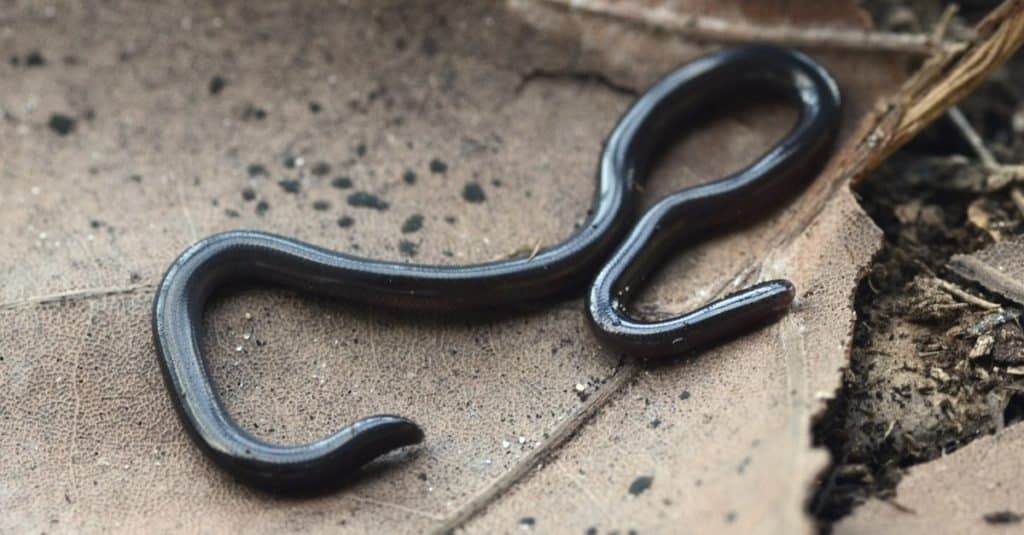
Brahminy Blind Snake
may get into the home along with potted plants, or come in from outside by crawling under doors or through cracks.
©Patrick K. Campbell/Shutterstock.com
The Brahminy blind snake is truly unique. Tiny and adapted to burrowing, these snakes are totally blind. Their size and appearance often result in them being mistaken for earthworms. They aren’t native to Florida, however, and arrived from Asia as an invasive species. Still, if you find a small black snake that doesn’t look like a snake, it’s likely this guy.
Appearance: Small black bodies with small heads. No visible eyes and rounded snout, giving the appearance of an earthworm with scales. Can grow to 6 inches in length.
Distribution: All of Florida, including the Keys.
Habitat: Urban, suburban, and agricultural regions.
Danger level: Low. Won’t bite, but will occasionally rub smelly stink glands found in the base of the tail.
Black Swamp Snake
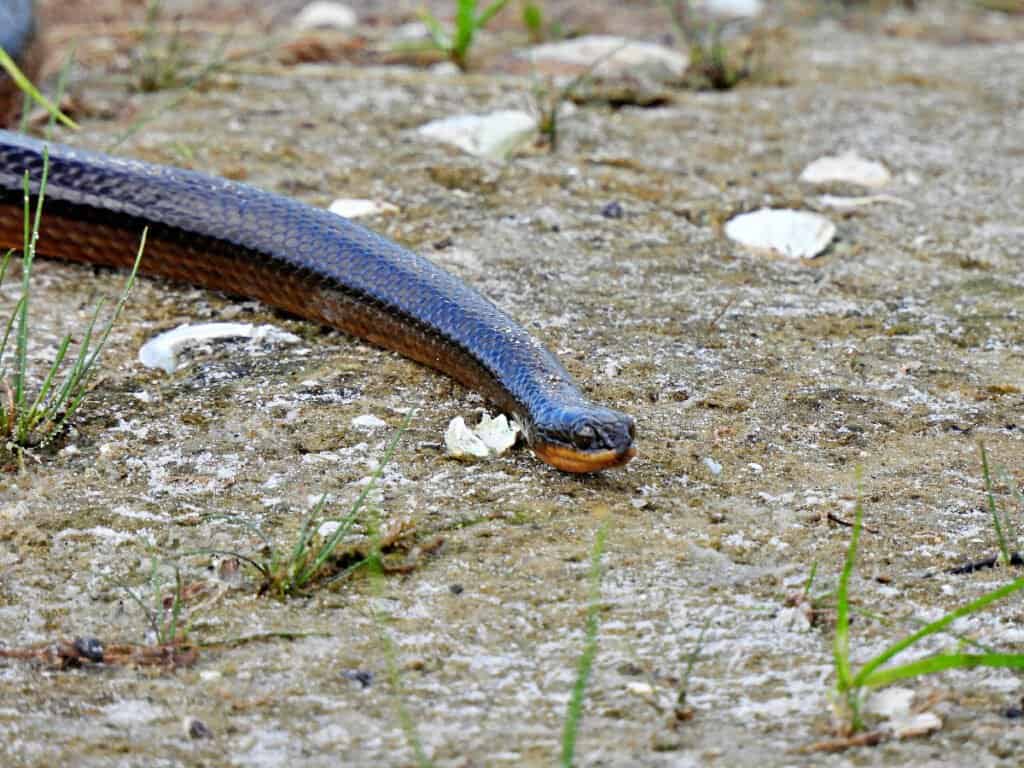
Black swamp snakes are glossy black and known for their vibrant bellies.
©iStock.com/passion4nature
The black swamp snake has two subspecies in Florida, but both of them can come in shades of black. These beautiful snakes are known for their vibrant bellies and for how they give birth to live young.
Appearance: Sleek black with thick bodies, Bright and vibrant red or orange bellies.
Distribution: Almost all of mainland Florida.
Habitat: As the name denotes, found near water, preferably swamps.
Danger level: Low. Nonvenomous.
Eastern Coachwhip
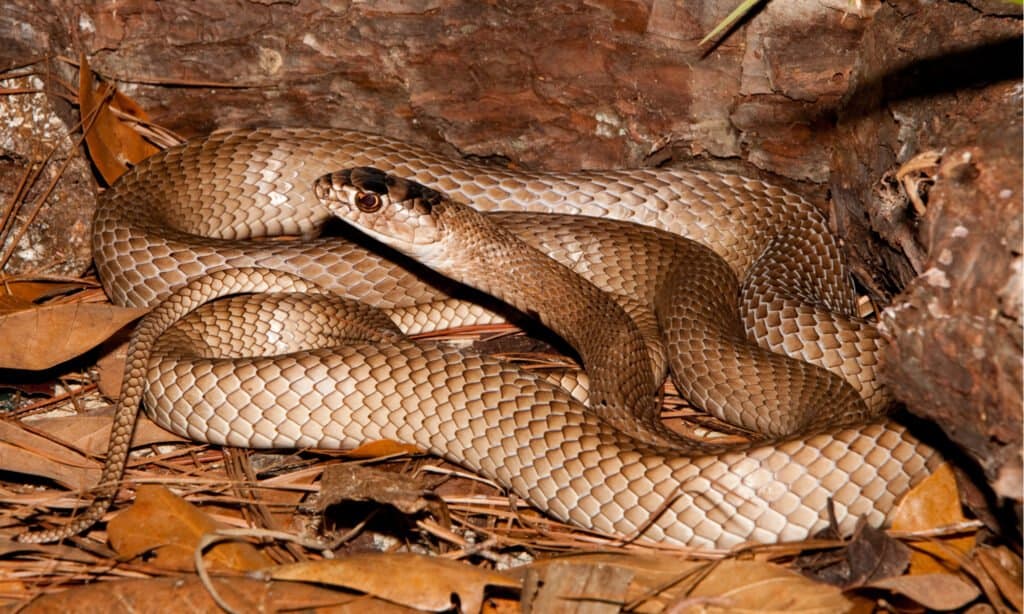
Eastern coachwhips can be black, tan, grey, or brown.
©Jay Ondreicka/Shutterstock.com
The eastern coachwhip is known for its flat black coloration (although the exact color can vary) and its climbing ability. Coachwhips are fast, agile, and can be easily confused with black racers and eastern indigo snakes.
Appearance: Black, brown, tan, or grey. Some have solid colors, but many have darker heads and lighter bodies. Can grow to 6 feet in length.
Distribution: Most of Florida except the Keys.
Habitat: Pine stands, sandhills, scrublands, and along beaches dunes.
Danger level: Low. Nonvenomous and more likely to run away.
Glossy Crayfish Snake
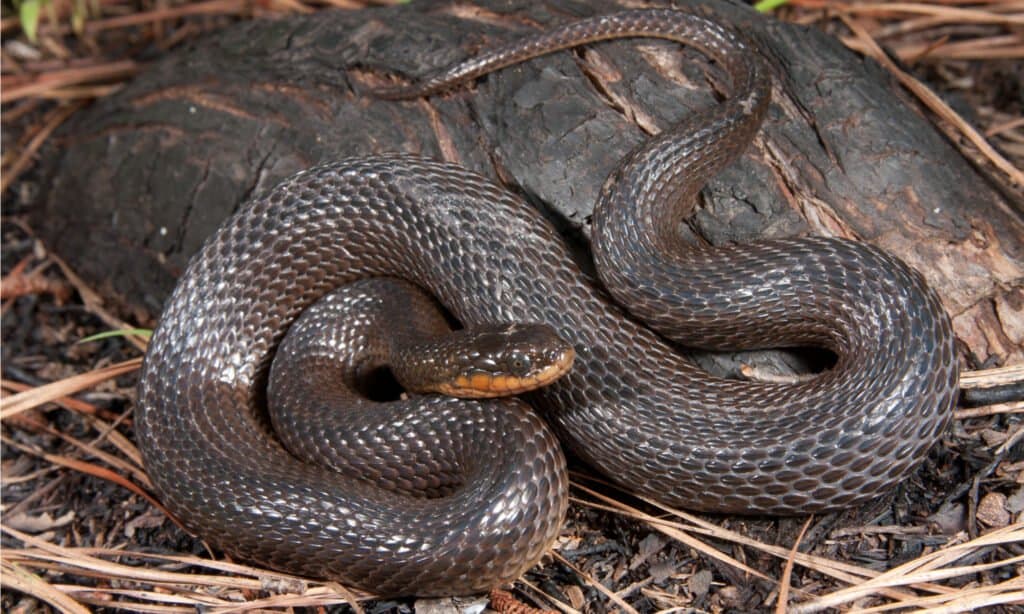
Glossy crayfish snakes are often found near water sources.
©Nathan A Shepard/Shutterstock.com
The aquatic glossy crayfish snake is usually seen after heavy rain but can also be found near water sources. They aren’t super common and eat a diet based on crayfish and other aquatic creatures (frogs, salamanders, and fish).
Appearance: Olive, brown, or black bodies with a lighter belly. A triangular pattern along the belly is a great tell. Can grow to 2 feet in length.
Distribution: Central Florida and in parts of the panhandle.
Habitat: Swamps, creeks, ponds, streams, and marshes.
Danger level: Low. Rare snakes that don’t often bite and are nonvenomous.
Eastern Mud Snake
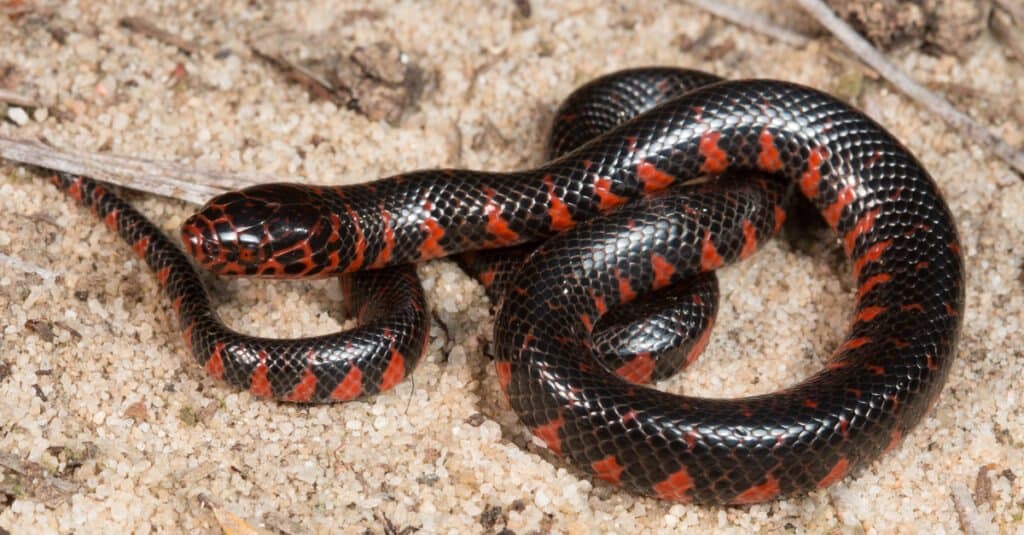
Mud
snakes can come
in different patterns, but are most often black with red bellies and detailing.
©Nathan A Shepard/Shutterstock.com
The eastern mud snake is easy to identify due to its unique coloration. With black backs and red bellies with black stripes and striations, most people know an eastern mud snake when they see one.
Appearance: Black backs with red bellies. Black patterns underneath on belly. Thick bodies with short heads. Can grow to 3.5 feet in length.
Distribution: All of Florida except the Keys.
Habitat: Swamps, marshes, drainage canals, rivers, lakes, and ponds. Pretty much anywhere there is mud.
Danger level: Low. Nonvenomous and famous for being docile.
The photo featured at the top of this post is © Patrick K. Campbell/Shutterstock.com
Discover the "Monster" Snake 5X Bigger than an Anaconda
Every day A-Z Animals sends out some of the most incredible facts in the world from our free newsletter. Want to discover the 10 most beautiful snakes in the world, a "snake island" where you're never more than 3 feet from danger, or a "monster" snake 5X larger than an anaconda? Then sign up right now and you'll start receiving our daily newsletter absolutely free.
Thank you for reading! Have some feedback for us? Contact the AZ Animals editorial team.







